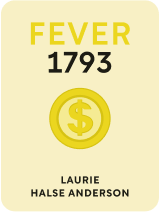

This article is an excerpt from the Shortform book guide to "Fever 1793" by Laurie Halse Anderson. Shortform has the world's best summaries and analyses of books you should be reading.
Like this article? Sign up for a free trial here .
Who is Eliza in Fever 1793? What role does Eliza play in Matilda’s life?
In Fever 1793, Eliza is a free black woman who worked for the family and without her, Matilda and her mother would be homeless. During the yellow fever outbreak, Eliza worked with the Free African Society to help the sick.
Keep reading to learn more about Eliza from Fever 1793.
Eliza in Fever 1793
In the book Fever 1793, Eliza is a very important person in Matilda’s life. Matilda loved Eliza for more than her cooking abilities. Eliza was kind and often slipped a sugar cube in the bottom of her bowl of oatmeal. Eliza was born into slavery in Virginia. When she married, her husband used his savings to buy her freedom. Eliza had been saving up to buy his, but he was killed by a wild horse. Eliza stopped speaking and went into a deep mourning, something Lucille knew well. The two women became connected through their sorrow. After a few years, Eliza’s light finally turned back on inside, but Lucille’s never did.
Eliza and the Epidemic
After being separated during the epidemic, seeing Eliza opened something up inside of Matilda. All the emotion she’d been holding inside since leaving for the farm came spilling out. She cried in front of Eliza until she released all her pain. Eliza’s first question was why Matilda wasn’t at the farm with her mother. When she found out Matilda and Grandpa had never made it there, she took Matilda and Nell home with her.
Eliza lived in an apartment with her brother, Joseph, and his two twin boys. Joseph was recovering from the fever, but his wife had not been so lucky. She’d died a few days before. The boys were close to Nell’s age, and the three played while Eliza and Matilda talked about everything that had happened since they’d last seen each other. Matilda tried to hide the bleak parts from her, but Eliza could always tell when she was lying. She forced Matilda to tell her the truth.
After Matilda told Eliza about the abandonment by the farmer, her stay at Bush Hill, and the intruders who’d killed Grandpa, she cried again. She felt responsible for everything that had happened and like a failure. Eliza pushed the notion away and shared her own story.
Lucille had recovered from the fever and headed to the farm to meet up with Matilda and Grandpa. After Lucille left, Eliza started helping the Free African Society to care for the sick. The doctors said black people couldn’t get the fever. The society’s leader, Reverend Allen, said it would be a good opportunity for black folks to prove their worth in society. Unfortunately, the doctors were wrong, and many of their members caught the fever and died. Those who hadn’t still went out every day to deliver food and care for inflicted families. She told Matilda they just had to make it until the first frost, when the whole thing would be over.
Eliza’s Work
Matilda couldn’t have imagined how hard it would be to work with Eliza, both physically and emotionally. She’d witnessed the sick and dying at Bush Hill, but it was different being in people’s homes. Helping to console those losing family members to the fever broke her heart.
She and Eliza left at dawn each day and didn’t return until dark. Joseph cared for the children during the day and had supper waiting for them when they came home. The heat had subsided for a few days, but today it was blazing again. Outside, it felt more like July than October.
Rumors abounded in the city: the fever was over, the fever was back, ships full of the sick were coming to the docks, a cure was found, there was no cure, the water was contaminated, and the redcoats were returning. Round and round these stories ran, but Eliza ignored them. Whether they were true or not had no bearing on the work of the moment.
From house to house, Eliza and Matilda cleaned and fed the sick. Matilda wore a vinegar-soaked rag around her face, but it couldn’t keep out the stench of the dying. They went to the apothecary, where Grandpa used to take Matilda to buy supplies and candy. She used to love this store and dreamt of having one just like it one day. Now, it was covered in dust and dead insects. Eliza was livid with the owner, who she felt was monopolizing on the misfortune of others by raising his prices.
When the two returned home that night, Joseph was sitting in candlelight in tears. The children, especially the boys, had fallen ill. Eliza was beside herself. She prayed for God to spare the children. Matilda suggested they take them to Bush Hill, but the journey was far, and there would likely not be room.
Matilda wanted to help but didn’t know how. Then it hit her. It was cooler near the city center. They could take them to the coffeehouse to recover. The plan was decided and preparations made.
A Fight for Life
Mother Smith secured a mule cart and brought it to Eliza’s house to transport the children to the coffeehouse. They packed all the medicine and food they could procure and put a mattress in the back. Joseph carried the boys to the mattress and was overcome with grief when he said goodbye. He was staying behind so he wouldn’t infect the children even more than he feared he had. Mother Smith promised the Society would look after him.
The trip to the coffeehouse was through a bleak city. Matilda had never seen the city so dark. There was no moonlight, no lanterns lit on the street, and hardly any candles flickered in the many windows.
At the coffeehouse, they pulled the mattress with the children on top into the front room. Matilda was worried about opening the windows again because of intruders. But Eliza pulled out a knife from her waistband and said she’d protect them.
The first floor looked the same as it had the night Grandpa died. The memories of that night and all the death and decay since weighed on Matilda. So much had happened in such a short amount of time.
The package from the linen cupboard was still on the floor. Matilda picked it up and found Nathaniel’s painting. She hoped he was staying inside and safe and not throwing flowers to every girl he saw passing by. She also wondered about her mother. Where was she? Was she still alive? There was so much she wanted to talk to her mother about.
But there was no time for sorrow. The boys’ eyes were bloodshot and yellow, and Nell wasn’t far behind. Eliza struggled with her emotions. She’d promised her sister-in-law that she’d keep the boys safe, but she knew they were losing the battle. Matilda told her not to worry. They were going to keep that promise.
For days, the two cared for the children. Matilda never worked so hard before in her life. When one child slept, the others cried. Nell started to lose her mind. She didn’t recognize Matilda and cried for her mother. Nights turned into days and back again. Matilda carried bucket after bucket of water from the well until her hands blistered and bled. Their supplies were low and the children weren’t improving. They were wasting away from the fever ravishing their tiny bodies.
Eliza wanted to call a doctor and have them bled, but Matilda warned her about what Bridget had said at Bush Hill. People died more frequently after being bled, and the French doctors with more experience said it was a dangerous practice. Eliza was adamant, but Matilda pleaded for Eliza to trust her. Bleeding would cause more harm than good. Finally, Eliza relented.
Late that night, Matilda went to fetch more water. She could barely crank the bucket back to the top of the well. She didn’t remember the last time she ate or slept. The candles from inside cast shadows across the dead garden. How long ago it felt that Matilda had planted the seeds or tossed the dead mouse out the window. How far away Grandpa’s laughter at the cat chasing the squirrel seemed now. Overcome with fatigue and memories, Matilda laid among the dried rows and fell asleep.

———End of Preview———
Like what you just read? Read the rest of the world's best book summary and analysis of Laurie Halse Anderson's "Fever 1793" at Shortform .
Here's what you'll find in our full Fever 1793 summary :
- What the yellow fever epidemic in 1793 in Philadelphia looked like
- How this epidemic exposed the vulnerability of everyone, including the wealthy
- How an epidemic can impact a young person






